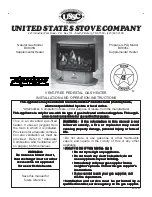
NEVER LEAVE HEATER UNATTENDED WHILE BURNING,
CONNECTED TO A POWER SOURCE, OR WHILE
CONNECTED TO A FUEL SOURCE
© 2015, Pinnacle Products International, Inc.
Convection Heater User's Manual
Ventilation
–
Risk of indoor air pollution and Carbon
Monoxide Poisoning. Use heater only in
well ventilated areas.
–
Refer to Safety Information on pages 1-2
for information about Carbon Monoxide
Poisoning.
–
ALWAYS
provide a fresh air opening in the
heated space of at least 3 square feet (2,800
sq. cm) for each 100,000 BTU / Hr. of heater
output. Provide a larger opening if more
heaters are being used.
– FOR OUTDOOR USE. INDOOR USE
PERMITTED ONLY FOR: The temporary
heating of adequately ventilated buildings or
structures under construction, alteration or
repair.
Minimum Ventilation
Opening Needed
HH-18-PCH-A
0.54 ft.
2
16.5 cm
2
CARBON MONOXIDE POISONING MAY LEAD TO DEATH!
DANGER
Not for use in residential
living areas or in
non-adequately ventilated enclosed spaces.
DANGER
Storage / Maintenance
Always disconnect the LP cylinder from the
regulator assembly and remove the LP cylinder
from the heater before putting the heater
into storage. If, for any reason, the heater is
to be stored indoors, the heater MUST be
disconnected from the LP cylinder, and the
cylinder stored outdoors in a well-ventilated area,
out of the reach of children, and in accordance
with the Standard for Storage and Handling of
Liquefied Gasses, ANSI/NFPA 58 - latest edition.
The plastic valve plug or valve cover supplied
with the LP cylinder must be reinstalled on the
valve to protect the fitting from damage.
NOTE: Repair of this heater should be done
by a qualified service person.
It is recommended that you save all of the
packaging materials that came with your heater,
and re-package the heater using these materials
for safe storage.
Debris, dust and dirt inside of the heater body
can affect the performance of your heater. This
debris can impair the heaters ability to draw air
for ventilation and combustion. Spiderwebs can
also appear during periods of inactivity.
Be sure to inspect the heater before each use to
look for any such obstructions. Be sure to keep
the air passage-ways, burner and combustion
areas clean. Wipe with a damp cloth or use
a vacuum cleaner to clean these areas. It is
suggested that you perform a thorough cleaning
at least once every 30 days of operation. You
may need to clean the heater more often if
conditions are naturally dirty.
Clean the ceramic plaques using compressed air
below 30 PSI to prevent damage to plaques.
A yellow tip of the pilot flame indicates that the
burner area may be in need of cleaning.
Never store an LP cylinder
inside of a building or near
any other gas or oil burning appliances.
Always be sure that the heater
has been allowed to cool for
at least 30 minutes before attempting to store,
service, or perform maintenance.
DANGER
9
CAUTION


































